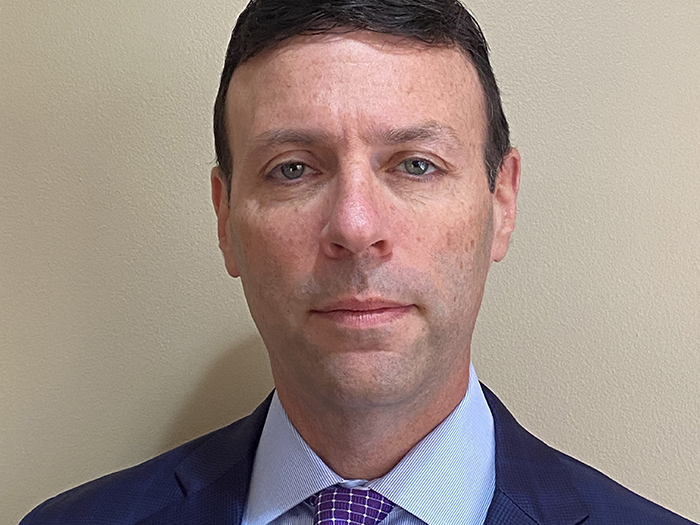Keith Freid of Berkshire Hathaway Specialty Insurance Shares Nonprofit Management Liability Insights

In March, Berkshire Hathaway Specialty Insurance announced that it had appointed Keith Freid as Product Line Officer for Private and Nonprofit Management Liability Insurance in North America. In April, Keith chatted with Risk & Insurance Editor-in-Chief Dan Reynolds about his new opportunity. What follows is a transcript of that discussion edited for clarity and length.
R&I: In your current position, can you tell us about the product or products you are responsible for?
KF: We call our products a management liability suite for private companies and nonprofit institutions or organizations. The lead product is typically the D&O product. Sometimes in the nonprofit context, it’s called a trustee’s and officer’s product because a lot of nonprofits call their directors trustees. It provides broader coverage, generally speaking, than a public company D&O form does for private companies and nonprofits. That’s largely a product of the way that these products expanded over the past 40 years.
Public companies had more of an understanding about the need for D&O insurance for their boards. It’s pretty easy to get the latest figures on the security class action filings or even on derivative claims or regulatory investigations or what the SEC might be up to – all relating to public companies.
For private companies and nonprofits, given that they don’t have publicly traded securities, for a long time folks even wondered if you needed to buy this coverage for those types of institutions. I guess fortunately and unfortunately, the litigation environment for private companies and nonprofits has changed so dramatically over the last 15 years. The litigation has gotten so much worse against the boards of both of those legal structures that nobody that we do business with now questions whether or not you need to buy it. Now, the question is how much do you need to buy for adequate coverage?
R&I: So is it fair to say, when you think of nuclear verdicts and social inflation, all these issues you deal with in management liability, that they are just as threatening for a nonprofit as they are for a publicly traded company?
KF : I would say yes. There’s just no clearing house for the information for nonprofits, though. A public company has the Stanford website or Cornerstone or other sources where you can go and look up all that data. There is no publicly available clearing house where you can go and look up what’s happening on D&O liability for nonprofits. And that’s a shame that there isn’t, because folks might not be aware of the potential pitfalls of sitting on a non-profit board.
R&I: Is part of what you do also communicating, “By the way, nonprofit board member, you may not know it, but you got some pretty serious exposures here.”?
KF: Educating the market is a big part of what we’ve been doing for a long time. We don’t do it client by client because that’s really more of the brokerage role, about what they need to buy, but we do it more generally across the market. We attend a lot of speaking engagements for customers and potential customers to talk about what we’re seeing and the types of claims that we’re seeing. We articulate why you should be thinking about buying this type of insurance and how much you would need to buy.
R&I: We all write and read about the magnitude of some of the jury awards we’re seeing; the litigation exposure. How have the types of claims been trending from your perspective, Keith?
KF: When a lot of folks think about this coverage, they think that the types of claims that these organizations face for this type of insurance coverage are centered around employment practices. And EPLI is a big part of what we sell, but that’s a whole different coverage section and it has claims that are not very different than what you see for a public company. Wrongful termination, discrimination, retaliation are typical types of EPLI claims. What I’m talking about are the true D&O claims, the claims that are the business decisions made by the management team and the board of directors that have a financial impact in the way of a loss that may be covered by this policy.
The types of things that have really impacted this coverage, and especially for nonprofits that are talking about it, are nonprofits almost by their nature, run on very thin margins. Without a margin, you have no mission for a nonprofit, and you need to maintain enough of a margin to maintain your mission. And in order to do that, that margin and the way they go about maintaining that margin is often questioned through litigation. Whether that be through some type of state law claim about unfair competition, or antitrust allegation as it may apply in the health care field, for example.
So that comes into play frequently with the larger organizations. However, a lot of folks sit on their local condo board, or they’ll sit on a board of a local charity or they’ll help with Big Brothers and Big Sisters. The condo board is probably the best example of that because condo boards make decisions that affect the people that are living in the residences. And it is not atypical for one of those decisions to impact one member of that condo association negatively. Their remedy is going to be to file a lawsuit. That lawsuit is going to attack the board and that board needs protection from that lawsuit. That’s where this policy would come into play.
R&I: I’m just imagining if you’re sitting on a co-op board of a high rise in Manhattan, that must be a pretty hot area.
KF: Everybody can envision the one person in that apartment or in that condo association who tends to be a little bit more vocal or vehement about enforcing their own rights. And you can see that person using the courts to do that.
R&I: Is it fair to say we see a lot of that?
KF: In my career, I have not written a lot of condo associations for that reason, that the risk adjusted returns to the premium just weren’t there for the liability we would be taking on. But even charities face litigation because every charity has expenses. Every dollar you give to that charity doesn’t go towards just the charitable end. Some of it goes to pay for their overhead and costs.
Charities have to hire people to run the charities and they have to pay them competitive wages. Those types of things get questioned with litigation from time to time about how much of every dollar that you’re taking in is actually going to the charitable cause and are you actually managing your expenses in a way that makes sense? That would be the type of claim that would be under a nonprofit D&O policy.
R&I: Keith, you talked about your history and not having a huge appetite for condo associations or residential co-ops. In your current department with your group, could you describe where you do have appetite? The kinds of things you… for lack of a better phrase, like to underwrite?
KF: So foundations, trustees, areas like that, we view to be on the lower end of the risk spectrum, and we could get our arms around what their exposures are. That’s not to say they don’t face claims because they do. And there aren’t that many markets competing for that business because it’s a little bit more complicated on the risk side. Then at the really high end, the two big areas in the nonprofit world are health care and higher education.
Sometimes folks lose sight of the fact that most of health care facilities in this country are set up as a nonprofit organizations. Most of the higher ed institutions that are the household names, are nonprofit organizations. Oftentimes, you’ll hear or read an article about people getting upset about the charges associated with health care and tuition associated with higher ed. The concept of nonprofit and those substantial charges don’t often wash in people’s minds.
But they’re set up as nonprofits. Depending on the size of the organization for large health care and higher ed, their boards can have a lot of prominent individuals. They make decisions that impact their local communities and that impact many different aspects of society. Those decisions and the way they run their businesses are often tested by litigation. The types of coverage that we sell is broad and provides coverage for their management team if they get tested by litigation.
R&I: You mentioned social inflation, you mentioned these nuclear verdicts. Can you give us a taste of what challenges the management liability market faces in nonprofit? Is there a pricing issue now or a capacity issue?
KF: I would say that the market is more favorable for the carriers than it has been in the last several years. The pricing environment has improved but that’s been driven by the losses. It’s been 100% driven by the loss environment that we’ve been talking about. A lot of it has to do with the business models of nonprofits, things that are tough to underwrite to, because they happen at all nonprofits, are getting challenged in the courts.
The best example I can give you for that, if we go back to our health care example of before, let’s say you go to the emergency room and you get your bill afterward and there were some surcharges on there. It is not uncommon to see a class action lawsuit filed claiming that those are charges that are inappropriate under the law. Most every hospital does it. Most every health care system does it. But you’ll see those types of claims. If you’re underwriting that risk, you know that every health care organization does it, you don’t know which one’s going to get sued for it. So you have to spread that risk. It changes the whole equation.
Years ago, when my nonprofit career started with health care, medical students coming out of medical school were systematically matched up with hospitals . You listed your first three choices, they put their first choices and you get matched up. It wasn’t a competitive marketplace for doctors coming out of medical school.
That whole practice was challenged through a class action lawsuit claiming that that practice violated antitrust laws, because it didn’t create a competitive marketplace. And arguably, that theory was correct and that lawsuit named hundreds of medical institutions. It didn’t name everyone, but it named hundreds of medical institutions. That lawsuit was resolved by an act of Congress, giving an antitrust exemption to that practice because without that exemption, the cost of health care would have gone up even more than it has over the last 20 years.
When you’re underwriting that risk and you see that’s happening, that’s a practice that happens at every single health care institution in the country where they hire doctors. So it’s hard to say that one does it better than the other, as you try to separate how you price out that risk. You just have to recognize that that exposure is just present in that industry for any of those institutions. And the premium has to adjust to the loss environment based on that systemic exposure.
R&I: Last question for you Keith and we appreciate the time you have given us. In terms of how you do your business and what you do, what about the culture at BHSI is working for you?
KF: The culture here is phenomenal. It really is about hiring the best people and allowing them to do what they’re good at, which is evaluate risk and determine which customers that we want to partner with. How we’re going to set terms and conditions and the pricing of those risks. As long as there’s a collaborative spirit at BHSI, you’re not going to get questioned about the decisions that you make, which is part of what people love about being here. It’s great. We look at some risks that are tough to place in the marketplace, but if we think that our underwriting skill allows us to understand and underwrite to those challenging risks, there’s an acceptance of that.
And the other thing is, most companies will say this, but BHSI lives this, is that when we partner with our customers, we usually don’t want to partner in just one line of coverage because it’s the high profile sale. We want to partner with our customers across multiple lines of coverage. We really want to be the solution for you. We’ll underwrite some tougher lines of coverage to place in the marketplace, because we want to really be a partner with you across all or most of your insurance needs. And if we do that, if we get a good balance in the lines of coverage that we place for our customers – we create a long term, sustainable trading relationship.










